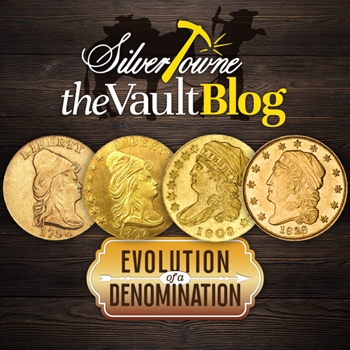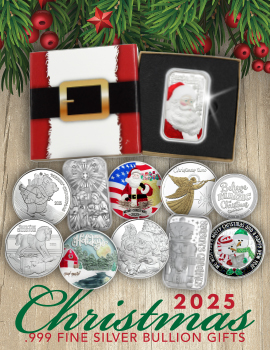
Authorized along with other denominations by the Mint Act of 1792, the quarter eagle ($2.50) was highly underwhelming and of little use to the public. The last to be minted and in small quantities, they represented a large amount of money, and many would not see that amount outside of the Philadelphia Mint’s walls. The cent, half dollar, and half eagle denominations would be the center of attention, leaving the quarter eagle in the dust so to speak. However, with small mintages comes massive demand in the years following their production. The quarter eagle denomination only proves this theory in spades.
Capped Bust to Right (1796-1807)
Designed by Chief Engraver Robert Scot, the first quarter eagle produced was the 1796 Capped Bust Without Stars. The obverse features Liberty facing right and wearing a soft cap. LIBERTY is inscribed above her and the date below. The reverse depicts a heraldic eagle, which was Scot’s interpretation of the Great Seal of the United States. Clouds are above, arced from wing to wing and enclosing 16 stars. Sixteen stars were used after Tennessee’s admission to the Union, but the Mint Director quickly realized the future difficulties of adding a new star after each admission of a state. This coin was named the No Stars variety. The stars were then moved to the obverse with Liberty in that same year, creating the 1796 Stars on Obverse variety.
While the 1797-dated Capped Bust quarter eagle changed the number of stars on the obverse from 16 to 13, the design on the reverse still featured the 16 stars above the eagle. This would fast-track the changing of designs on both sides and end the Capped Bust series in 1807. Of the 427 pieces minted in 1897, there are only 20 examples known to have survived. The 1798-dated coin saw two different reverses (either four or five berries on the olive branch). Quarter eagles were not produced again until 1802 and are considered one of the few “common dates” as a little over 3,000 were produced.
Draped Bust to Left, Large Size (1808)
With growing criticisms of Chief Engraver Robert Scot, Mint Director Robert Patterson hired John Reich to replace Scot in 1807. Reich would be tasked to improve all the designs for all the denominations, including the quarter eagle. He created a pair of single dies for the 1808 Quarter Eagle which features Liberty facing left on the obverse, wearing a modern cap inscribed with LIBERTY. Many criticized this new take, deeming the depicting of Liberty as “the artist’s fat mistress.” On the reverse, Reich also replaced the heraldic eagle with a spread-winged bird on an olive branch, going for a more natural looking depiction.
Only 2,710 1808 Quarter Eagles were produced, making them an instant rarity. There were several factors contributing to such a low mintage, including the overwhelming demand for half eagles and the fact that there was only one die prepared for quarter eagles in 1808. Die failure is said to have limited production to fewer coins than originally planned. As the die breaking led to the halt of its production, the little to no demand led to the decision to no longer continue minting the quarter eagle denomination. Some say fewer than 50 are known to still exist.
Capped Head to Left (1821-1834)
Reich would leave the Mint in 1817, and former Chief Engraver Scot would waste no time replacing his designs. One of them would include the quarter eagle, which had not been in production since 1808 due to die issues and little demand. However, it would reappear in 1821 with Scot’s Capped Head design. After production issues and the impact of war, the demand for quarter eagles returned.
Liberty faces left wearing a headdress with 13 stars surrounding her on the obverse. The date is featured below with LIBERTY seen in her cap. An outstretched eagle is showcased on the reverse with E PLURIBUS UNUM above it and UNITED STATES OF AMERICA surrounding it on all sides. The denomination, 2 ½ D., is seen below.
This design would be produced until 1827 when William Kneass, who took over after Scot’s death in 1823, would modify the coin by reducing its diameter. The smaller diameter would take over in 1829 and be minted until 1834 when all gold coinage was given a facelift as part of the Coinage Act of 1834.
Source: NGC Coin; The Official 2024 Red Book







